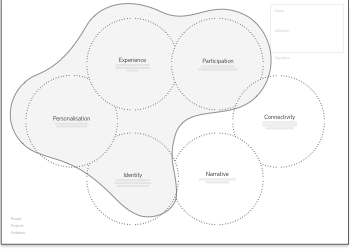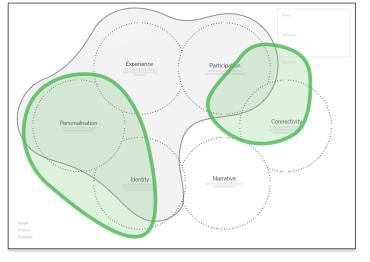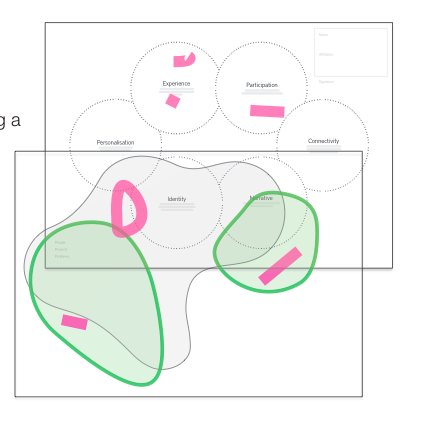Coral Grainger reflects on the mapping exercise carried out for the Creative Exchange
Could I devise a more perfect assignment than to chat, in confidence, with 22 of the most interesting people in NW creative industries, and imagine the ways that their business might change in the years ahead? Probably not, and so it was that I, with my toolkit of tracing paper and highlighters, and a big pregnant belly, set off to gather and map CX knowledge from our partners across Manchester, Lancashire and Cheshire.
Prior to my engagement in March 2012, Leon Cruikshank & Roger Whitham of LICA and Jo-Anne Bichard of the RCA had developed a Knowledge Exchange process, to ensure a consistent approach for curation across all CX interviews – whether conducted by myself in the Northwest with support from Tom Popay and Sara Gancho, or by colleagues based in Newcastle and London, covering their own respective patches.
On an A3 sheet, the 6 CX themes of Experience; Participation; Connectivity; Narrative; Identity; and Personalisation are identified in adjacent bubbles, like a cloud of digital opportunity. Step 1 of the interview is a kind of ‘word association’ game in which the partner jots in each bubble (or I jot for them) with a skinny black Sharpie, what is going on in, for example, Connectivity – who is doing interesting work, which activities/businesses/thought leaders are pushing the boundaries? This phase of the interview was somewhat ‘marmite’ – we were working with a cohort of imaginative and creative people – so you can imagine that they own had their own style and approach to the task, and some felt that guidelines were meant to be broken, but that was half the fun, and all part of the value.
Some partners would hear the themes and launch into a stream of consciousness which began in one bubble, but then realised it should be in another, covering the page with enthusiastic arrows and asterisks. Others might not relate to the themes at all, or may even be hostile towards them as concepts or terms, but with conversation and exploration, we managed to produce fascinating diagrams in all cases. This first stage was highly effective in starting the conversation, establishing partner perspective, and discovering common points of reference – key to interpretation and exchange.
With Step 2, I would bring out the tracing paper ‘ta-dah!’ and with the same black pen, the interviewees would draw a line to delineate the ‘existing experience’ of their organisation. For instance, a shape drawn by a data store owner might fully encompass the Identity bubble, but barely touch Narrative, whilst a game developer might have a degree of presence within each realm.
The green highlighter came into play for Step 3, often accompanied by some scratching of heads then bursts of energy and enthusiasm. The green pen was used to highlight the ‘areas of future excitement’ for their business. The combination of Steps 1&2 whet the appetite for further discussion, sparking new ideas or firming up existing thoughts about the future direction of the business. In some cases, the partner had a very strong sense
of purpose and mandate, and the black and green lines would be identical in shape, suggesting “This is what we do, we do it well, and will continue to do so in the future”. In other instances, there was a recognition of changing business models, changing customer expectations, or just new found interests that might steer the company into a totally new arena.
Occasionally as a result of our conversation, an idea for a new service or product would emerge, leading to the questions, “what would we need to take us there? what skills? what knowledge? what connections?” These opportunities and needs would also be annotated with the green pen of the future. Although, in practice, this section would take a relatively small amount of time, this is the essential output of the CX Curate phase. It would be these brief green notes that would identify synergies in partner interests and requirements, connections for collaborative teams, and opportunities for academic input.
Finally, our partners would review the maps, decipher my scribbles to check that I had understood and recorded correctly, and add any further points that in retrospect had been missing from our notes. Step 4 involved the pink highlighter to add emphasis to the half dozen or so most important points we had discussed, and identify key terms that would feed into the database of CX partner priorities and key terms.
Of course, our interest is arts and technologies which evolve in the field, and the result is that many people use different terminology for similar or related developments. For instance, cross platform/ transmedia/ pervasive/ multiscreen/ 4th screen, all have their own definitions and wouldn’t be matched on a database, but through conversation the curation team is able to identify complementarity of interests within the varied phraseology.
I found the CX Knowledge Exchange process effective, and importantly, enjoyable to use. However, successful creative collaborations are rarely born in shared terminology and datasets, they grow through shared passion, shared beliefs and complementary natures and approaches to life and work. So however accurate the annotation in any Knowledge Exchange process, the role of the curator is critical. It is empathy and emotional intelligence that notices the spark in certain areas of discussion, where you just know that they would ‘hit it off’ with a partner you met with last week, and that the whole they could create would be far greater and beyond any of the ideas they record individually.
So as my colleagues bring the next CX phase to life, I’ll be watching the Clusters with interest to see if emerging projects had their initial sparks in the interviews I was privileged to conduct. But also I hope that long term, trust based relationships are formed that will create great work in the years and decades to come, long after CX has officially ended.
Thanks to all the CX team for the support and opportunity, and special thanks to everyone I interviewed for a fascinating and fun three months, I can’t wait to experience the results.




